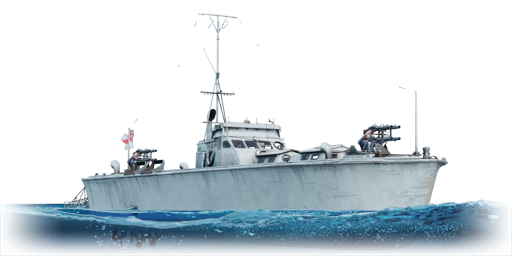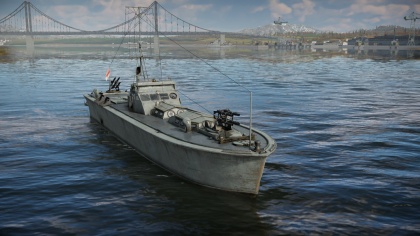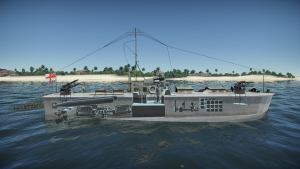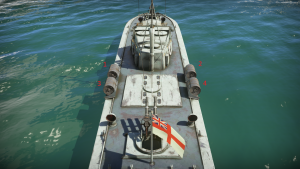Difference between revisions of "MTB-1(1)"
(Hull-break info correction; removed added pro (not actually a pro); "ammunition choice" -> ammumition type"; various minor wording changes) |
(W.I.P, new info additions and moving info to more appropriate sections) (Tag: Visual edit) |
||
| Line 11: | Line 11: | ||
{{break}} | {{break}} | ||
The '''{{Specs|name}}''' is a reserve Rank {{Specs|rank}} British motor torpedo boat {{Battle-rating}}. It was introduced in [[Update 1.83 "Masters of the Sea"]] as part of the British fleet closed beta test. {{PAGENAME}} is the Reserve vehicle for the British naval tech tree. | The '''{{Specs|name}}''' is a reserve Rank {{Specs|rank}} British motor torpedo boat {{Battle-rating}}. It was introduced in [[Update 1.83 "Masters of the Sea"]] as part of the British fleet closed beta test. {{PAGENAME}} is the Reserve vehicle for the British naval tech tree. | ||
| + | |||
| + | The MTB-1 is a wooden patrol boat serving as an introduction for the British fast crafts tree. These boats are highly agile and very fast, equipped with decent torpedoes and depth charges. The main drawback is without a doubt, its armament. The 2x turrets of 4x Lewis machine 1916 guns feel outdated and lack the needed power to quickly dispatch other fast boats. Tactics and ability is needed to exploit this boat on the treacherous archipelagos of War thunder. | ||
| + | |||
| + | MTB-1 1 series is a reserve vehicle. As such, it has no repair costs and can be respawned up to three times per battle. | ||
== General info == | == General info == | ||
| Line 27: | Line 31: | ||
Any gun in the game will easily be able to penetrate the hull and superstructure at any practical range. | Any gun in the game will easily be able to penetrate the hull and superstructure at any practical range. | ||
| − | {{PAGENAME}} can be hull-broken by any round with a large enough diameter and a large enough explosive mass. In general, this is limited to HE rounds fired from guns greater than 4 inches (102 mm) in diameter. Hull-break triggers when such a round hits and destroys any hull compartment — or in some cases, the bridge — upon which the rest of the boat is destroyed. At {{PAGENAME}}' battle rating, there is only one gun capable of hull-breaking her: | + | {{PAGENAME}}can be hull-broken by any round with a large enough diameter and a large enough explosive mass. In general, this is limited to HE rounds fired from guns greater than 4 inches (102 mm) in diameter. Hull-break triggers when such a round hits and destroys any hull compartment — or in some cases, the bridge — upon which the rest of the boat is destroyed. At {{PAGENAME}}'s battle rating, there is only one gun capable of hull-breaking her: |
* the [[8cwt QF Mk I (114 mm)|8cwt QF Mk I]], found on {{Specs-Link|uk_dark_class}}. | * the [[8cwt QF Mk I (114 mm)|8cwt QF Mk I]], found on {{Specs-Link|uk_dark_class}}. | ||
| Line 33: | Line 37: | ||
The hull is split into three compartments. The first compartment starts at the bow and ends after the ammunition storage; the second ends just behind the bridge; and the third ends at the stern. | The hull is split into three compartments. The first compartment starts at the bow and ends after the ammunition storage; the second ends just behind the bridge; and the third ends at the stern. | ||
| − | {{PAGENAME}} has one ammunition storage that holds ammunition for both the fore and aft gun turrets. It is located directly behind the forward gun turret just above the waterline. Destroying it will instantly destroy the boat. Note that the ammunition storage says that it contains 7,760 rounds of ammunition; this is most likely a bug, since {{PAGENAME}} can only carry a maximum of 3,880 rounds. | + | {{PAGENAME}}has one ammunition storage that holds ammunition for both the fore and aft gun turrets. It is located directly behind the forward gun turret just above the waterline. Destroying it will instantly destroy the boat. Note that the ammunition storage says that it contains 7,760 rounds of ammunition; this is most likely a bug, since {{PAGENAME}} can only carry a maximum of 3,880 rounds. |
With a crew complement of 10, {{PAGENAME}}' overall survivability is below-average. | With a crew complement of 10, {{PAGENAME}}' overall survivability is below-average. | ||
| Line 58: | Line 62: | ||
}} | }} | ||
| − | {{PAGENAME}} has a displacement of 22.4 tons. | + | {{PAGENAME}}has a displacement of 22.4 tons. |
| − | |||
== Armament == | == Armament == | ||
=== Primary armament === | === Primary armament === | ||
| Line 65: | Line 68: | ||
<!--Provide information about the characteristics of the primary armament. Evaluate their efficacy in battle based on their reload speed, ballistics and the capacity of their shells. Add a link to the main article about the weapon: <code><nowiki>{{main|Weapon name (calibre)}}</nowiki></code>. | <!--Provide information about the characteristics of the primary armament. Evaluate their efficacy in battle based on their reload speed, ballistics and the capacity of their shells. Add a link to the main article about the weapon: <code><nowiki>{{main|Weapon name (calibre)}}</nowiki></code>. | ||
| − | Broadly describe the ammunition available for the primary armament, and provide recommendations on how to use it and which ammunition to choose.--> | + | Broadly describe the ammunition available for the primary armament, and provide recommendations on how to use it and which ammunition to choose.-->The primary armament consists of eight 7.72 mm Lewis 1916 machine guns in two quadruple mounts, one on the bow and one on the stern. There are 1,940 rounds of ammunition available for each mount, 485 rounds per gun, for a total of 3,880 rounds. Stock, the mounts can traverse horizontally and vertically at a rate of 64°/s; with the "Primary Armament Targeting" modification installed, this is increased to 75°/s. Each gun has a magazine capacity of 97 rounds and a cyclic rate of fire of 550 rounds/min. With a stock crew, the guns can be reloaded in 18.2 seconds; with an aced crew, they can be reloaded in 14 seconds. |
| − | The | + | The best ammunition type is the 7.7 mm AP belt since it has the highest ratio of AP to T rounds. While the 7.7 mm API belt may look tempting because of the incendiary tracer rounds and lack of tracer rounds, the incendiary rounds (IT) can actually be stopped by some wooden hulls and almost all metal hulls. Additionally, their damage output is closer to that of the standard tracer round than the AP round, and they rarely start fires, if ever. While the incendiary rounds (IT) rounds are technically the best against aircraft, with such a long reload time to switch to the API belt and with barely any noticeable difference, there's really no point in using the Armor piercing incendiary (API) belt for that either. Sailors should be prone to only the Armor piercing (AP) belt. |
{{Notice|Turrets are named sequentially, clockwise, starting at the bow}} | {{Notice|Turrets are named sequentially, clockwise, starting at the bow}} | ||
| Line 113: | Line 116: | ||
If there is no torpedo armament, remove this section.--> | If there is no torpedo armament, remove this section.--> | ||
| − | {{PAGENAME}} can carry two 18 inch Mark XII torpedoes. These are carried internally in the aft of the boat and are launched through the transom tail first, i.e. facing forwards. | + | {{PAGENAME}}can carry two 18 inch Mark XII torpedoes. These are carried internally in the aft of the boat and are launched through the transom tail first, i.e. facing forwards. |
| + | |||
| + | The 18-inch Mk.XII is fairly average in terms of maximum speed and range, though it has a rather small explosive mass compared to other torpedoes. Still, a hit with the Mk.XII torpedo is more than enough to destroy any boat. Besides that, this torpedo is unnoteworthy. | ||
| + | |||
| + | Once unlocked, always have the Torpedo Mode modification installed. The higher maximum speed is much more valuable against the fast boats of this tier, and the maps are small enough that the decreased maximum range doesn't really matter. | ||
| + | |||
| + | * If using torpedoes, be aware that, unless already launched, the torpedoes can be shot at, and, if destroyed, there is a chance for them detonate. To avoid this, fire the torpedoes early on or simply don't take them at all. Torpedoes are a situational weapon, so it's largely down to personal preference whether you want to take them or not. | ||
{| class="wikitable" style="text-align:center" width="100%" | {| class="wikitable" style="text-align:center" width="100%" | ||
| Line 145: | Line 154: | ||
[[File:{{PAGENAME}}_DC_Order.png|thumb|Mk.VII depth charges numbered according to their drop order (click to view a larger image).]] | [[File:{{PAGENAME}}_DC_Order.png|thumb|Mk.VII depth charges numbered according to their drop order (click to view a larger image).]] | ||
| − | {{PAGENAME}} has four possible loadouts: | + | {{PAGENAME}}has four possible loadouts: |
# 2x Mk.XII torpedo | # 2x Mk.XII torpedo | ||
| Line 151: | Line 160: | ||
# 2x Mk.XII torpedo, 4x Mk.VII depth charge | # 2x Mk.XII torpedo, 4x Mk.VII depth charge | ||
# Without load | # Without load | ||
| + | |||
| + | '''Depth Charges''' | ||
| + | |||
| + | There is no practical reason to use depth charges on any naval vessel in the game. Although they usually result in a one-hit kill if used properly, they are extremely situational and are actually a liability in most cases, since they essentially act as exposed ammo racks before they're dropped. | ||
| + | |||
| + | With some luck though, sailing up right next to a slower target and dropping a depth charge can lead to some success. If attempting this, remember the depth charge drop order and set the depth charge time delay to the minimum 3 seconds, since any higher time delay will only mean that the depth charge will sink further, and thus away, from the target. Again, this is extremely situational, and you will be better off not using depth charges at all. | ||
The Mk.VII depth charges are carried behind the bridge in racks, two on each side. They are dropped one at a time in the following order: | The Mk.VII depth charges are carried behind the bridge in racks, two on each side. They are dropped one at a time in the following order: | ||
| Line 177: | Line 192: | ||
[[File:MTB-1_1_series_skin_"MTB-1_'01'".png|thumb|MTB-1 1 series with the historical camouflage '''"MTB-1 '01'''', available on the [http://trade.gaijin.net Gaijin Marketplace].]] | [[File:MTB-1_1_series_skin_"MTB-1_'01'".png|thumb|MTB-1 1 series with the historical camouflage '''"MTB-1 '01'''', available on the [http://trade.gaijin.net Gaijin Marketplace].]] | ||
| − | MTB-1 | + | MTB-1's main armament only consists of low-caliber machine guns, so the damage output per hit is very low, though this is somewhat mitigated since she actually has quite a large amount of guns, eight in total. Regardless, the guns will always be held back by their low mass and muzzle velocity, severely limiting their maximum range. Despite this, the guns have a relatively large magazine compared to other guns at this tier, 97 rounds, and, with a rate of fire of 550 rpm, MTB-1 1 series can sustain about 10.58 seconds of fire. |
| − | |||
| − | |||
| − | |||
| − | |||
| − | |||
| − | |||
| − | |||
| − | |||
| − | |||
| − | |||
| − | |||
| − | |||
| − | |||
| − | |||
| − | |||
| − | |||
| − | |||
| − | |||
| − | |||
| − | |||
| − | |||
| − | |||
| − | + | Assuming that the shots are well-aimed, this is generally more than enough to destroy many boats at this tier before having to reload, unlike some other reserve boats like {{Specs-Link|ussr_g5_mtb}}, {{Specs-Link|jp_t14_class}}, and {{Specs-Link|it_mas_classe500_3_1944}}. Be careful though, since MTB-1 1 series has the longest reload of most reserve boat. Because of this, it's always best to empty the magazines after each engagement to then reload while it's safe; getting caught out during a reload is the last thing you want to happen. | |
| − | + | Sailors must remember the MTB-1 1 series only carries enough ammunition for five reloads, so only fire when you know you can land the shots and stick to close-range engagements so that the gun's low maximum range doesn't become an issue. The firing arc for the forward gun mount is very good. It is able to fire in all directions except in a ~34° arc directly behind it. The same can't be said though of the rear gun mount though. Because of the depth charge racks, even if they're empty, the rear gun cannot target any close-range targets in a ~42° arc on each side facing forwards. It also can't fire in a ~28° arc directly behind either. Because of this, MTB-1 1 series needs to show more of its side to get the rear gun mount on target, and, considering the low damage output of the guns, getting as many guns on target is a necessity. | |
| − | |||
=== Modules === | === Modules === | ||
| Line 252: | Line 244: | ||
'''Pros:''' | '''Pros:''' | ||
| − | * Relatively large magazine capacity | + | * Relatively large magazine capacity can destroy most opponents without needing to reload |
| + | * 8x Lewis machine guns can destroy light biplanes quickly | ||
'''Cons:''' | '''Cons:''' | ||
| − | * | + | * Only small-caliber firepower: low damage output per gun and low maximum range |
* Longest reload of any reserve boat | * Longest reload of any reserve boat | ||
* Below-average survivability | * Below-average survivability | ||
| Line 268: | Line 261: | ||
These boats had a standard displacement of 18 tons and had a length of 60 ft. 4 in., a width of 13 ft. 4 in., and a drought of 2 ft. 10 in. at standard displacement. They were powered by three Napier Sea Lion petrol engines, each driving a single shaft, and could reach speeds of around 30-35 knots. Each boat could carry two 18 inch torpedoes which were stored internally on rails above the engines. On the stern were two more rails that could be folded down to the transom, extending the torpedoes' rails outside of the boat. The torpedoes fired facing forwards down the rails, after which the boat that fired them would have to turn to evade their path. In addition to torpedoes, the boats were also armed with a number of depth charges and, depending on the exact boat, up to eight Lewis guns. | These boats had a standard displacement of 18 tons and had a length of 60 ft. 4 in., a width of 13 ft. 4 in., and a drought of 2 ft. 10 in. at standard displacement. They were powered by three Napier Sea Lion petrol engines, each driving a single shaft, and could reach speeds of around 30-35 knots. Each boat could carry two 18 inch torpedoes which were stored internally on rails above the engines. On the stern were two more rails that could be folded down to the transom, extending the torpedoes' rails outside of the boat. The torpedoes fired facing forwards down the rails, after which the boat that fired them would have to turn to evade their path. In addition to torpedoes, the boats were also armed with a number of depth charges and, depending on the exact boat, up to eight Lewis guns. | ||
| − | MTB 1, the first of the boats, was redesignated MTB 7 in 1937. Similarly, MTB 7 was redesignated MTB 1 in the same year. In 1938, the former MTB 1, now MTB 7, was | + | MTB 1, the first of the boats, was redesignated MTB 7 in 1937. Similarly, MTB 7 was redesignated MTB 1 in the same year. In 1938, the former MTB 1, now MTB 7, was re-designated MTB 13. At the same time, MTB 13 was redesignated MTB 7. Finally, later in 1938, the former MTB 1, now MTB 13, was again re-designated MTB 19. Thus, by the start of WWII, the boats were numbered MTBs 1-12 and 14-19 and formed two MTB flotillas: 1st MTB Flotilla, consisting of MTBs 1-6 and 14-19; and 2nd MTB Flotilla, consisting of MTBs 7-12. |
The 1st MTB Flotilla was sent to the Mediterranean at the start of WWII and was based at HMS Vulcan in Malta. They were soon recalled back to England in December 1939 to be based at HMS Beehive, Felixstowe, though MTB 19 was sent to HMS Vernon, Portsmouth. Along the way back, due to bad weather, MTB 6 had to be foundered. After they arrived, the remaining boats continued to operate in the English Channel until they were either lost or replaced. Those lost were MTBs 15, 16, and 17, all of which were mined in 1940. | The 1st MTB Flotilla was sent to the Mediterranean at the start of WWII and was based at HMS Vulcan in Malta. They were soon recalled back to England in December 1939 to be based at HMS Beehive, Felixstowe, though MTB 19 was sent to HMS Vernon, Portsmouth. Along the way back, due to bad weather, MTB 6 had to be foundered. After they arrived, the remaining boats continued to operate in the English Channel until they were either lost or replaced. Those lost were MTBs 15, 16, and 17, all of which were mined in 1940. | ||
Revision as of 06:46, 13 November 2020
Contents
| This page is about the British motor torpedo boat MTB-1(1). For other versions, see MTB-1 (Family). |
Description
The MTB-1 1 series is a reserve Rank I British motor torpedo boat
with a battle rating of 1.0 (AB/RB/SB). It was introduced in Update 1.83 "Masters of the Sea" as part of the British fleet closed beta test. MTB-1(1) is the Reserve vehicle for the British naval tech tree.
The MTB-1 is a wooden patrol boat serving as an introduction for the British fast crafts tree. These boats are highly agile and very fast, equipped with decent torpedoes and depth charges. The main drawback is without a doubt, its armament. The 2x turrets of 4x Lewis machine 1916 guns feel outdated and lack the needed power to quickly dispatch other fast boats. Tactics and ability is needed to exploit this boat on the treacherous archipelagos of War thunder.
MTB-1 1 series is a reserve vehicle. As such, it has no repair costs and can be respawned up to three times per battle.
General info
Survivability and armour
MTB-1(1) has the following armour layout:
- Hull: 24 mm, wood
- Superstructure: 2 mm, steel
Any gun in the game will easily be able to penetrate the hull and superstructure at any practical range.
MTB-1(1)can be hull-broken by any round with a large enough diameter and a large enough explosive mass. In general, this is limited to HE rounds fired from guns greater than 4 inches (102 mm) in diameter. Hull-break triggers when such a round hits and destroys any hull compartment — or in some cases, the bridge — upon which the rest of the boat is destroyed. At MTB-1(1)'s battle rating, there is only one gun capable of hull-breaking her:
- the 8cwt QF Mk I, found on Dark Adventurer.
The hull is split into three compartments. The first compartment starts at the bow and ends after the ammunition storage; the second ends just behind the bridge; and the third ends at the stern.
MTB-1(1)has one ammunition storage that holds ammunition for both the fore and aft gun turrets. It is located directly behind the forward gun turret just above the waterline. Destroying it will instantly destroy the boat. Note that the ammunition storage says that it contains 7,760 rounds of ammunition; this is most likely a bug, since MTB-1(1) can only carry a maximum of 3,880 rounds.
With a crew complement of 10, MTB-1(1)' overall survivability is below-average.
Mobility
| Mobility Characteristics | |||||
|---|---|---|---|---|---|
| Game Mode | Upgrade Status | Maximum Speed (km/h) | Turn Time (s) | Turn Radius (m) | |
| Forward | Reverse | ||||
| AB | Stock | 63 | 32 | ~18.64 | ~35.43 |
| Upgraded | 86 | 43 | ~12.67 | ~22.41 | |
| RB/SB | Stock | 53 | 26 | ~20.77 | ~36.73 |
| Upgraded | 61 | 31 | ~17.44 | ~33.15 | |
MTB-1(1)has a displacement of 22.4 tons.
Armament
Primary armament
The primary armament consists of eight 7.72 mm Lewis 1916 machine guns in two quadruple mounts, one on the bow and one on the stern. There are 1,940 rounds of ammunition available for each mount, 485 rounds per gun, for a total of 3,880 rounds. Stock, the mounts can traverse horizontally and vertically at a rate of 64°/s; with the "Primary Armament Targeting" modification installed, this is increased to 75°/s. Each gun has a magazine capacity of 97 rounds and a cyclic rate of fire of 550 rounds/min. With a stock crew, the guns can be reloaded in 18.2 seconds; with an aced crew, they can be reloaded in 14 seconds.
The best ammunition type is the 7.7 mm AP belt since it has the highest ratio of AP to T rounds. While the 7.7 mm API belt may look tempting because of the incendiary tracer rounds and lack of tracer rounds, the incendiary rounds (IT) can actually be stopped by some wooden hulls and almost all metal hulls. Additionally, their damage output is closer to that of the standard tracer round than the AP round, and they rarely start fires, if ever. While the incendiary rounds (IT) rounds are technically the best against aircraft, with such a long reload time to switch to the API belt and with barely any noticeable difference, there's really no point in using the Armor piercing incendiary (API) belt for that either. Sailors should be prone to only the Armor piercing (AP) belt.
| Turrets are named sequentially, clockwise, starting at the bow |
| Primary Armament Guidance | |||
|---|---|---|---|
| No.1 Turret (fore) | No.2 Turret (aft) | ||
| Horizontal | Vertical | Horizontal | Vertical |
| ±180° | -5°/+43° | ±160° | -5°/+43° |
There are three ammunition types available:
- Universal: AP · T · AP · T
- 7.7 mm AP belt: AP · AP · AP · T
- 7.7 mm API belt: IT · IT · IT · AP
| Penetration Statistics | ||||||
|---|---|---|---|---|---|---|
| Ammunition | Penetration @ 0° Angle of Attack (mm) | |||||
| 10 m | 100 m | 500 m | 1,000 m | 1,500 m | 2,000 m | |
| Universal | 10 | 9 | 8 | 7 | 6 | 5 |
| 7.7 mm AP belt | 10 | 9 | 8 | 7 | 6 | 5 |
| 7.7 mm API belt | 10 | 9 | 8 | 7 | 6 | 5 |
Torpedo armament
MTB-1(1)can carry two 18 inch Mark XII torpedoes. These are carried internally in the aft of the boat and are launched through the transom tail first, i.e. facing forwards.
The 18-inch Mk.XII is fairly average in terms of maximum speed and range, though it has a rather small explosive mass compared to other torpedoes. Still, a hit with the Mk.XII torpedo is more than enough to destroy any boat. Besides that, this torpedo is unnoteworthy.
Once unlocked, always have the Torpedo Mode modification installed. The higher maximum speed is much more valuable against the fast boats of this tier, and the maps are small enough that the decreased maximum range doesn't really matter.
- If using torpedoes, be aware that, unless already launched, the torpedoes can be shot at, and, if destroyed, there is a chance for them detonate. To avoid this, fire the torpedoes early on or simply don't take them at all. Torpedoes are a situational weapon, so it's largely down to personal preference whether you want to take them or not.
| Torpedo Characteristics | ||||||||
|---|---|---|---|---|---|---|---|---|
| Torpedo Mode | Mass (kg) | Maximum speed in water (km/h) | Travel distance (km) | Depth stroke (m) | Arming distance (m) | Explosive type | Explosive mass (kg) | TNT equivalent (kg) |
| No | 702 | 50 | 3.20 | 1 | 50 | TNT | 176 | 176 |
| Yes | 74 | 1.37 | ||||||
The Torpedo Mode modification is available as a rank IV modification. Installing it will give the following changes:
| Torpedo Mode Specification Changes | |
|---|---|
| Max Distance (m) | Max Speed (m/s) |
| -1829 | +7 |
Note that the Torpedo Mode modification on MTB-1(1) has the opposite effect compared to most other vehicles. Typically, the maximum range is increased at the cost of speed.
Special armament
MTB-1(1)has four possible loadouts:
- 2x Mk.XII torpedo
- 4x Mk.VII depth charge
- 2x Mk.XII torpedo, 4x Mk.VII depth charge
- Without load
Depth Charges
There is no practical reason to use depth charges on any naval vessel in the game. Although they usually result in a one-hit kill if used properly, they are extremely situational and are actually a liability in most cases, since they essentially act as exposed ammo racks before they're dropped.
With some luck though, sailing up right next to a slower target and dropping a depth charge can lead to some success. If attempting this, remember the depth charge drop order and set the depth charge time delay to the minimum 3 seconds, since any higher time delay will only mean that the depth charge will sink further, and thus away, from the target. Again, this is extremely situational, and you will be better off not using depth charges at all.
The Mk.VII depth charges are carried behind the bridge in racks, two on each side. They are dropped one at a time in the following order:
- Port, foremost
- Starboard, foremost
- Port, aftmost
- Starboard, aftmost
Before spawning, the detonation time delay can be set anywhere between 3 seconds and 10 seconds.
| Depth Charge Characteristics | |||
|---|---|---|---|
| Mass (kg) | Explosive Type | Explosive Mass (kg) | TNT Equivalent (kg) |
| 196 | TNT | 130 | 130 |
Usage in battles
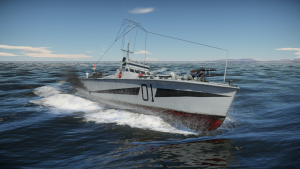
MTB-1's main armament only consists of low-caliber machine guns, so the damage output per hit is very low, though this is somewhat mitigated since she actually has quite a large amount of guns, eight in total. Regardless, the guns will always be held back by their low mass and muzzle velocity, severely limiting their maximum range. Despite this, the guns have a relatively large magazine compared to other guns at this tier, 97 rounds, and, with a rate of fire of 550 rpm, MTB-1 1 series can sustain about 10.58 seconds of fire.
Assuming that the shots are well-aimed, this is generally more than enough to destroy many boats at this tier before having to reload, unlike some other reserve boats like G-5, Type T-14, and MAS 561. Be careful though, since MTB-1 1 series has the longest reload of most reserve boat. Because of this, it's always best to empty the magazines after each engagement to then reload while it's safe; getting caught out during a reload is the last thing you want to happen.
Sailors must remember the MTB-1 1 series only carries enough ammunition for five reloads, so only fire when you know you can land the shots and stick to close-range engagements so that the gun's low maximum range doesn't become an issue. The firing arc for the forward gun mount is very good. It is able to fire in all directions except in a ~34° arc directly behind it. The same can't be said though of the rear gun mount though. Because of the depth charge racks, even if they're empty, the rear gun cannot target any close-range targets in a ~42° arc on each side facing forwards. It also can't fire in a ~28° arc directly behind either. Because of this, MTB-1 1 series needs to show more of its side to get the rear gun mount on target, and, considering the low damage output of the guns, getting as many guns on target is a necessity.
Modules
| Tier | Seakeeping | Unsinkability | Firepower | |||
|---|---|---|---|---|---|---|
| I | Dry-Docking | Tool Set | 7.7 mm AP belt | |||
| II | Rudder Replacement | Fire Protection System | Smokescreen | 7.7 mm API belt | ||
| III | Propeller Replacement | Primary Armament Targeting | Depth Charges | |||
| IV | Engine Maintenance | New Pumps | Artillery Support | Torpedo Mode | ||
Pros and cons
Pros:
- Relatively large magazine capacity can destroy most opponents without needing to reload
- 8x Lewis machine guns can destroy light biplanes quickly
Cons:
- Only small-caliber firepower: low damage output per gun and low maximum range
- Longest reload of any reserve boat
- Below-average survivability
- Relatively weak torpedoes (low explosive mass compared to other similar torpedoes)
History
Though the Royal Navy had operated a small number of coastal boats during the first World War, by the 1930s, these flotillas had long been dissolved and the Royal Navy had yet to construct any more. The first two coastal boats since WWI were ordered on 27th September 1935 by the Royal Navy, the order being given to British Power Boat Company based at Hythe, a town near Southampton. In addition to this initial order, four more were ordered on 19th October 1935. These six boats were completed by November 1936, and, with their commissioning on 27th April 1937, the Royal Navy Coastal Forces was founded. Following this, three more boats were ordered on 7th December 1936 and nine more on 11th January 1938. In total, 18 boats were ordered, all of them being completed by 1939.
These boats had a standard displacement of 18 tons and had a length of 60 ft. 4 in., a width of 13 ft. 4 in., and a drought of 2 ft. 10 in. at standard displacement. They were powered by three Napier Sea Lion petrol engines, each driving a single shaft, and could reach speeds of around 30-35 knots. Each boat could carry two 18 inch torpedoes which were stored internally on rails above the engines. On the stern were two more rails that could be folded down to the transom, extending the torpedoes' rails outside of the boat. The torpedoes fired facing forwards down the rails, after which the boat that fired them would have to turn to evade their path. In addition to torpedoes, the boats were also armed with a number of depth charges and, depending on the exact boat, up to eight Lewis guns.
MTB 1, the first of the boats, was redesignated MTB 7 in 1937. Similarly, MTB 7 was redesignated MTB 1 in the same year. In 1938, the former MTB 1, now MTB 7, was re-designated MTB 13. At the same time, MTB 13 was redesignated MTB 7. Finally, later in 1938, the former MTB 1, now MTB 13, was again re-designated MTB 19. Thus, by the start of WWII, the boats were numbered MTBs 1-12 and 14-19 and formed two MTB flotillas: 1st MTB Flotilla, consisting of MTBs 1-6 and 14-19; and 2nd MTB Flotilla, consisting of MTBs 7-12.
The 1st MTB Flotilla was sent to the Mediterranean at the start of WWII and was based at HMS Vulcan in Malta. They were soon recalled back to England in December 1939 to be based at HMS Beehive, Felixstowe, though MTB 19 was sent to HMS Vernon, Portsmouth. Along the way back, due to bad weather, MTB 6 had to be foundered. After they arrived, the remaining boats continued to operate in the English Channel until they were either lost or replaced. Those lost were MTBs 15, 16, and 17, all of which were mined in 1940.
The 2nd MTB Flotilla was commissioned in 1938 and assigned to HMS Tamar, Hong Kong. They were all lost during the Battle of Hong Kong in December 1941. MTB 8 was bombed by IJN aircraft and was damaged beyond repair, and MTB 12 was sunk in action by IJN landing craft. The remainder of the 2nd MTB Flotilla was scuttled on 26th December 1941.
Media
See also
External links
- unithistories.com - Royal Navy Coastal Forces 1940-1945
- naval-history.net - British vessels lost at sea in World War 2 - MGB, MTB, SGB, ML, etc - originally published in British Vessels Lost at Sea, 1935-45, His Majesty's Stationary Office, 1947
- mwadui.com - Royal Navy Coastal Forces - Hong Kong
- Coastal Forces Heritage Trust - History
- yalumba.co.uk - British Power Boat Co Page 1 and British Power Boat Co Page 5
- Wikipedia - Coastal Forces of the Royal Navy
| Britain boats | |
|---|---|
| Motor torpedo boats | Brave Borderer · Dark Aggressor · Dark Aggressor TD · Fairmile D (617) · Fairmile D (697) · Fairmile D (5001) · HMS Gay Archer |
| MTB-1(1) · MTB-1(2) · MTB Vosper · MTB Vosper(2) · MTB-422 | |
| Motor gun boats | Dark Adventurer · Fairmile A (ML100) · Fairmile B (ML345) · Fairmile C (312) · Fairmile C (332) · Fairmile D (601) · Fairmile H LCS(L)(2) |
| HMAS Arrow · HMAS Fremantle · MGB-61 · MGB-75 · ML 1383 · SGB Grey Fox · SGB Grey Goose | |
| Gunboats | HMS Spey |


